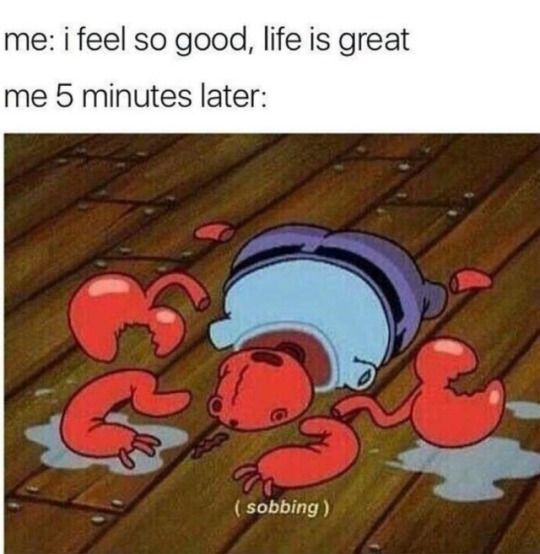Text
BPD, Ever Heard of It?
*Everyone who took this survey asked to remain anonymous and I want to respect that. What they said will be in quotes but I will not include names anywhere in this post*
This week I spent my free time talking with and giving surveys to people who are diagnosed with BPD. They were able to give me some more insight into their personal experiences with BPD and how it and its stigma affects their daily lives.
The first question I asked them to answer was “how does BPD make you feel?” Because none of the question I asked were required, this one got the most replies. A lot of the replies were similar. People said they felt heavy, trapped, and scared. The most emotional response I got stated that BPD made them feel frozen. Not frozen like unable to move, frozen like unable to speak, unable to think, unable to express emotions. Another feeling I received that, to me, expressed the fragile nature of people with BPD was “I feel like I’m made of glass.” Almost any comment can break someone with BPD because of how we experience emotions. This is a feeling common among people with BPD. It is a feeling, however, that is hard to express. Because of the stigma associated with the disorder people often feel those of us with BPD are over exaggerating, but that’s part of the disorder. Because everything feels over exaggerated, when people with BPD try to talk about their feelings, they often come across as over exaggerating.
This brings me to the second question I asked: “has the stigma affected you? If so, how?” Less people answered this question than the first one because it takes a lot more willingness to share this kind of thing than a single word. The responses I did get were heartbreaking: people’s families treat them differently because they are “tainted”, doctors have refused to see and treat them, and they find it hard to make friends because “no one wants to befriend someone so insecure.” Someone even described acting in a way that fits the stigma to validate themselves (a big part of BPD is needing validation and being worried you are acting in a certain way just for attention). They said that they will “sometimes do things to get attention even though I know I shouldn’t. I feel like if I don’t then I don’t really have BPD because I don’t act the way people with BPD ‘are supposed to act’.” Someone else said that, because of the stigma, they “don’t like to share [their] feelings because [they’re] afraid of coming across as manipulative.” That isn’t a way that anyone should ever feel and it is, unfortunately, how a lot of us diagnosed with BPD do feel.
The last question got the least amount of responses because it asked “how do you deal with BPD?” The responses I got stated that it depends on the day. Some days they “have a lot of mood swings” and that causes them not to want to deal with it, but some days they just pet dogs and that is the most helpful thing. Both people who were willing to tell me about how they deal with it said they self medicate, which is not uncommon for people with BPD because it subdues intense feelings. These people did want to assure me that they “know it is bad to self medicate but [they] haven’t found anything, including [their] PRESCRIBED MEDICINES, that work half as well.”
People with BPD have to live with all of these feelings that they have towards themselves and expectations other people have of how they will act every day. Believe me when I tell you it’s not easy. Even though none of the questions asked how hard living with BPD was, every person said something that indicated it was hard; and it’s even harder when the stigma is against you.
Hopefully this last post has helped open your eyes to just how harmful BPD and its stigma can be to those of us who suffer from BPD. As always, if you have any questions about BPD, the stigma, or how you can help, I am here to talk.
Questions for further research:
How many people are diagnosed with BPD annually?
What can I do to help?
1 note
·
View note
Text
so long mental stability, it’s Abandonment Time™
756 notes
·
View notes
Conversation
fp: *slightly changes tone*
me: wow wow wow wow wow you're leaving me
5K notes
·
View notes
Text
REBLOG IF THIS RELATES TO YOU:
AHHHHHHHHHHHHHHHHHHHHHHHHHHHHHHHHHHHHHHHHHHHHHHHHHHHHHHHHHHHHHHHHHHHHHHHHHHHHHHHHHHHHHHHHHHHHHHHHHHHHHHHHHHHHHHHHHHHHHHHHHHHHHHHHHHHHHHHHHHHHHHHHHHHHHHHHHHHHHHHHHHHHHHHHHHHHHHHHHHHHHHHHHHHHHHHHHHHHHHHHHHHHHHHHHHHHHHHHHHHHHHHHHHHHHHHHHHHHHHHHHHHHHHHHHHHHHHHHHHHHHHHHHHHHHHHHHHHHHHHHHHHHHHHHHHHHHHHHHHHHHHHHHHHHHHHHHHHHHHHHHHHHHHHHHHHHHHHHHHHHHHHHHHHHHHHHHHHHHHHHHH!!!!!!!!!!!
241K notes
·
View notes
Conversation
Me: hey I'm not feeling good today and I need some time alone
Someone: oh okay I'll give you some space
My BPD ass: nO WAIT DON'T ABANDON ME
3K notes
·
View notes
Text
Someone: why are you always so clingy??
Me:

54K notes
·
View notes
Text
God I just love that *clenches fist* mood drop
785 notes
·
View notes
Text
“People with BPD are People, Too”
Over the course of the past few days I have been interviewing people who know little about BPD and the stigma attached to it. I have asked them a variety of questions about themselves and about people with BPD. Unsurprisingly, not many people had heard of BPD or the stigma. By conducting these interviews I learned what things people don’t know about BPD. In other words, what aspects of BPD need to be talked about more. Not only did I learn about what people know (and don’t know) about BPD, I learned about how to interview people when the subject of the interview can be a touchy one.
Question: What is BPD?
The replies to this question varied quite a bit. Some people replied bipolar disorder or said “I don’t know.” Those who knew what BPD meant tended to report that they were close with someone who has been diagnosed with BPD by a professional. Of the five people that said they knew individuals with BPD, four of them said they had a friend with BPD and one said she had a friend and mom with BPD.
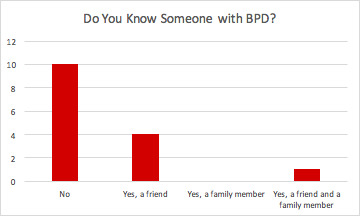
The people who said they knew what BPD was also went more in depth. One told me that “BPD is a mental illness and deserves to be treated with the same sincerity as any other mental illness. People with BPD are people too and I don’t think a lot of people have that idea down all the way.” Other people who said they knew people with BPD also said similar things. They all agreed that people with BPD shouldn’t be treated like less of a person even if they can be difficult to handle sometimes. One person mentioned that because of her friend’s BPD she is able to empathize and care so deeply that some people don’t even realize it is a disorder.
Question: Are you aware of the stigma surrounding BPD?
This question was asked only to those people who said they had heard of BPD but didn’t personally know anyone with BPD. Because I didn’t interview a large amount of people, the responses to this question came from three individuals. One said that he knew of stigmas surrounding all mental health issues but didn’t know there was a stigma specifically referring to BPD because he has only heard of the disorder in his psychology class. The other two had a little more knowledge on the subject.
One girl stated that she was aware of the stigma and she tended to avoid people with BPD because of it. She said that she didn’t want to be in a relationship, platonic or otherwise, with someone who “needs so much attention all the time.”
The last girl also said she knew about the stigma but she didn’t want that to impact how she treated people. She told me that “[clinginess, being dramatic, mood swings, being manipulative] can be found in almost everyone, they just become more exaggerated in people with BPD so I don’t see why we should treat them any differently.”
Question: Should people be educated on BPD and its stigma? If so, how?
The general consensus between the people I interviewed was that people should be educated on what BPD is, its stigma, and how we can help people with BPD. When I asked if they had ideas, people tended to go quiet. With further probing, one interviewee said she believed that “maybe health classes should spend time devoted to mental illnesses that are not commonly talked about.” I agree with her that this could be a start to raising awareness for BPD. Others did not know what to say but they believed that people should be more educated and when I told them the response of the girl I mentioned before, they also agreed with her.
Another simple way to learn and raise awareness is looking at blogs such as this one. In my last entry I explained what BPD is. I asked all the people I interviewed to read my last blog entry in response to this question. All of them (15 people total) said that they had learned something new because of the entry.

Based on the interviews I conducted, people don’t really understand BPD or its stigma, but they are willing to learn. This is an important quality for people to have if we want to someday end the stigma surrounding BPD.
If you have any questions about BPD, its stigma, or what you can do, feel free to ask!
Questions for further research:
Why is this stigma so much more prevalent than other stigmas?
Can
I
do something to help those affected by the stigma?
0 notes
Text
What is a Personality Disorder?
A personality disorder is a mental disorder that results most commonly from a childhood trauma. This trauma can be just about anything from something physical such as abuse or something emotional like neglect. In the DSM-V (Diagnostic and Statistical Manual 5), a personality disorder can only be diagnosed if it meets certain criteria. Here is a list of the criteria in terms that make sense
1. Hard time accepting yourself and hard time keeping good relationships with yourself and others.
2. Has unusual behaviors associated with an aspect of personality (in psychiatric terms, this is called a domain).
3. This unusual behavior is shown in most contexts and has been shown for a long time.
4. There is no better explanation for this trait (through developmental stage, where you live, how well off your family is, etc).
5. This behavior cannot be explained solely by drugs or a medical condition (head trauma, other mental disorders).
Personality disorders fall into 3 categories called clusters. They are named, very creatively, Cluster A, Cluster B, and Cluster C. Cluster A is the “odd, eccentric” cluster and has Paranoid, Schizoid, and Schizotypal Personality Disorders. Cluster B is often referred to as the "dramatic, emotional, erratic" cluster and has Narcissistic, Histrionic, Antisocial, and Borderline Personality Disorders. The last cluster, the “anxious, fearful” cluster c has Avoidant, Dependent, and Obsessive-Compulsive Personality Disorders. Each category has it’s own criteria and, even more specifically, each disorder has it’s own criteria. The category that I am focusing on is Cluster B, the disorder is Borderline Personality disorder.
What is Borderline Personality Disorder?
Borderline Personality Disorder, BPD for short, is a Cluster B personality disorder. This means that people who have BPD tend to be very dramatic and emotional as well as make impulsive decisions. The criteria for BPD is different from most Cluster B personality disorders because it also has a lot of symptoms similar to those personality disorders in Cluster C. The diagnostic material in the DSM-V for BPD includes:
A. Hard time:
1. Accepting yourself (a or b):
a. Identity: poor self-image, hard on yourself, chronic emptiness, dissociation
b. Self-direction: Instability in goals, values, or career plans.
AND
2. Having relationships with others (a or b):
a. Empathy: recognizing the feelings and needs of others associated with being hypersensitive (i.e., prone to feel insulted); tend to see others weaknesses first.
b. Intimacy: Intense, unstable, and conflicted close relationships, accompanied by mistrust, neediness, and anxiety over real or imagined abandonment; close relationships are either idealized or devalued and alternate between over involvement and withdrawal.
B. Unusual behaviors in the following domains:
1. Negative Emotions, characterized by:
a. Emotional liability: Frequent mood changes; emotions are easily aroused, intense, and/or out of proportion to events and circumstances.
b. Anxiousness: Intense feelings of nervousness, tenseness, or panic, often in reaction to interaction with people; a lot of worry involving past events and the negative impact they had/might have and future negative possibilities; feeling fearful or threatened by uncertainty; fears of falling apart or losing control.
c. Separation insecurity: Fears of rejection by – and/or separation from – significant others, usually accompanied excessive dependency and complete loss of self reliance.
d. Depressivity: Frequent feelings of being down, miserable, and/or hopeless; difficulty recovering from such moods; pessimism about the future; pervasive shame; feeling of inferior self-worth; thoughts of suicide and suicidal behavior.
2. Disinhibition, characterized by:
a. Impulsivity: doing things without fully thinking through them, especially not thinking about outcomes; hard to make and stick to plans; urgent and self- harming behavior when emotionally distressed.
b. Risk taking: willing engagement in dangerous, risky, and potentially self- damaging activities, without regard to consequences; no care for personal limits or personal danger.
3. Antagonism, characterized by:
a. Hostility: Persistent or frequent angry feelings; easily irritated or angry (maybe over a small insult).
C. This unusual behavior is shown in most contexts and has been shown for a long time.
D. There is no better explanation for this behavior (through developmental stage, where you live, how well off your family is, etc).
E. This behavior cannot be explained solely by drugs or a medical condition (head trauma, other mental disorders).
What Kind of Stigma Does BPD Have Attached to it?
BPD’s stigma is one of the most harmful stigmas that exists in the mental health community. In an article published in the Harvard Psychiatric Review, Aviam et al. explain that many people, health care professionals included, are influenced by the stigma of BPD. The stigma involves being uncooperative, needy, manipulative, and destructive. In this same article the authors state that these people also are under the impression that everything a borderline does is in their control. Aviam is quick to point out that this isn’t always the case. A psychotherapist in Vermont, Rachel Kling, has personal experience with this. In one of her articles she talks about being rejected by many therapists who heard she was a borderline and refused to treat her. This is one of the dangers of the stigma associated with BPD. She is trying to reduce the stigma by not refusing treatment to other people who suffer from BPD.
While there are many people trying to reduce the stigma, it is a hard topic to cover. Many people don’t understand it and the people who do don’t always care enough to help. As I continue research I hope to talk more about how people with BPD feel affected by the stigma.
Questions for Further Research
Why do people stigmatize BPD?
Why don’t people make an effort to help?
When was BPD recognized by the APA as a mental health condition?
What are different ways to treat BPD?
What are different ways to help bring about awareness for the stigma?
Why is this stigma worse than Others?
Suggested Reading
American Psychiatric Association. "Personality Disorders." Diagnostic and Statistical Manual of Mental Disorders: DSM-5. 5th ed. Arlington: American Psychiatric Association, 2013. 372-78. Print.
Aviram, Ron B., et al. "Borderline Personality Disorder, Stigma, and Treatment Implications." Harvard Review of Psychiatry (Taylor & Francis Ltd), vol. 14, no. 5, Sep/Oct2006, pp. 249-256, EBSCOhost, eds.b.ebscohost.com.du.idm.oclc.org/ehost/pdfviewer/pdfviewer?vid=1&sid=b273dd85-bd76-4282-a0fd-d35ce674d65e%40sessionmgr120&hid=111
Hoermann, Simone, et al. “DSM-5 The Ten Personality Disorders.” MentalHealth.net, 6 December 2013, https://www.mentalhelp.net/articles/dsm-5-the-ten-personality-disorders-cluster-a/ Accessed 24 April 2017
Kling, Rachel. “Borderline Personality Disorder, Language, and Stigma.” Ethical Human Psychology and Psychiatry 16, no. 2 (2014): 114-119. IngentaConnecthttp://docserver.ingentaconnect.com.du.idm.oclc.org/deliver/connect/springer/15594343/v16n2/s4.pdf?expires=1492798590&id=90498558&titleid=75001819&accname=University+of+Denver%2C+Penrose+Library&checksum=605BCEC52E838C5F60A82B075C44AC5A
1 note
·
View note
Photo
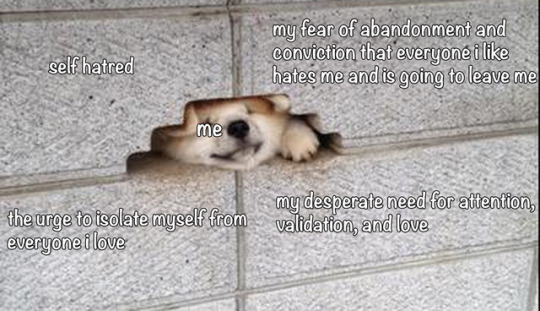
bpd got me like
311 notes
·
View notes
Photo
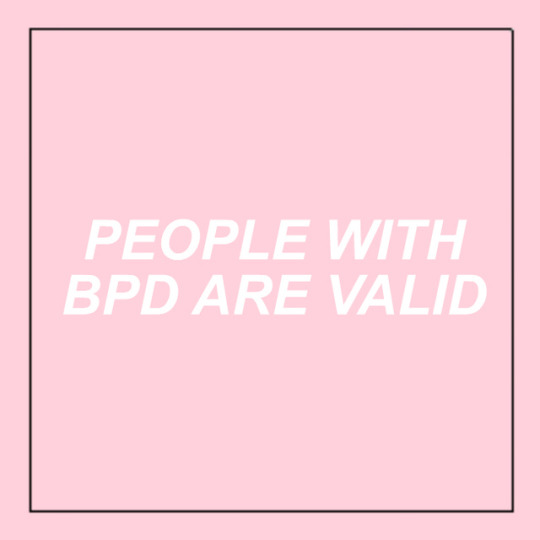
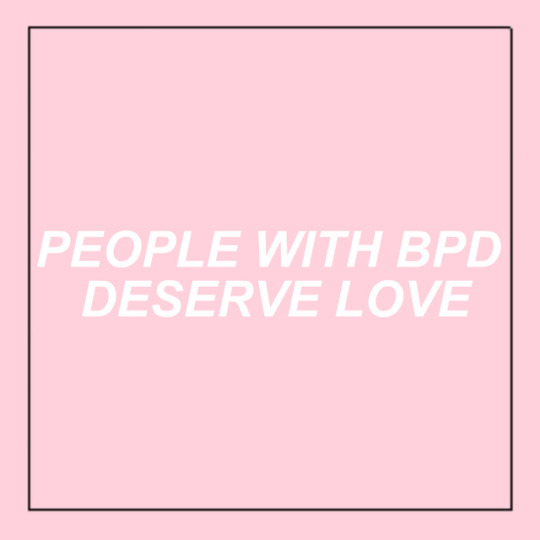
from one bpd person to another..
2K notes
·
View notes
Text
This was a very good an well written post! The information was presented in an engaging way and I didn’t get bored. I did not know San Diego was so into medicine!
Also there is a part in the pharmaceutical section where you quoted Mike Varney and they quote doesn’t really make sense. Like maybe you forgot some words??? If you didn’t, yikes on me.
A brief glance at San Diego culture: Does San Diego really have something for everyone?
“Stay classy, San Diego.”
Have you ever heard a line so poetic? Has anything ever spoken so clearly to the depths of your soul?
Perhaps not, but either way, you probably recognized the quote. Whether you’ve seen Will Ferrell’s Anchorman or not, the chances are high that you understood the reference and are now thinking about either Ferrell’s comedic genius, or San Diego. My hope is that you’re picturing the sunny, balmy, relaxing city of San Diego, with its crystal blue waters and luscious palm trees. Perhaps you’re envisioning yourself touring the tropical paradise, and wondering what the city really has to offer besides it’s pop-culture one-liners. If so, you’re in luck: keep reading for your all inclusive guide to the current culture of San Diego.
Founded in 1542, San Diego was first inhabited by Spaniards and was used jointly as a missionary and a harbor. It has since grown to be the 8th largest city in America, boasting a total of 1,301,621 residents. Every year, masses of citizens migrate to the southern coastal city, and it’s no wonder why: San Diego offers something for everyone.
Surfer’s Paradise
When one thinks of San Diego, or Southern California in general, one would tend to think about the surf culture. From movies to books to clothing lines, everyone can see that San Diego represents the ultimate surfer’s paradise.
This culture was acknowledged nationally in 2011 in Surfer magazine. This magazine, the largest and most circulated surfing magazine in the US, declared that when it came to the top universities for students that enjoyed surfing, San Diego held five of the top ten positions. More recently in 2013, the University of California, San Diego was awarded runner up for the same award by the “Surf Channel” (a nationally broadcasted television channel). UCSD released a press release regarding the award, and Chancellor Pradeep K. Khosla praised the school by saying that “in addition to being an academic powerhouse, [our] vibrant campus community and incredible location on the Pacific Ocean offer students a variety of unique opportunities outside the classroom.“
However, this draw of surfing isn’t just for those in college. Many Southern California cities (most of which are in the greater San Diego area) make much of their revenue from surfing tourism. Tourists come from all over the United States to camp or lodge on the ocean side in hopes of catching some waves, or at the very least, learning to catch said waves (it could be argued that some of us–me–might never leave the ‘learning’ phase).
Pharmaceutical Industry
One of the most surprising things San Diego has to offer is its ever growing pharmaceutical industry. Since the turn of the century, San Diego has become a hotbed for large medical research facilities, including big names such as Johnson & Johnson.
The close proximity to students at top research institutions in the Silicon Valley and the research done at UCSD makes San Diego a prime spot for these new industries. Currently, the pharmaceutical industry is one of the top employers in San Diego, and continues to grow every year.
Writer for Nature journal, Paul Smaglik, discusses this trend in his article “Best of Both Worlds”, noting the strong connections between these companies and the research done by local universities, such as the University of California, San Diego. Smaglik interviews Mike Varney, VP of drug discovery with the company Pfizer, who notes that research done by UCSD “was a contributing factor to setting up diabetes and obesity as a therapeutic area [in San Diego]… and a useful consulting relationship now exists between the company and [UCSD]”.
As one can see, San Diego truly has something for everyone. Whether it’s the love for the great outdoors or a love for helping others through science, San Diego has a ton of options. For students, San Diego offers a wide variety of universities with a focus on the outdoors, and an environment for growth after graduation. For adults, San Diego offers a vast amount of employment opportunities and a growing city with new offerings every season.
Questions for Further Research:
What does San Diego offer for families?
What type of cultures are represented in San Diego?
What are some of the most popular places to visit in San Diego and why?
What are popular times to visit San Diego?
Suggestions for Further Reading:
Smaglik, Paul. "Best of both Worlds.” Nature, vol. 426, no. 6967, 2003, pp.
706-7, ProQuest Central; SciTech Premium Collection,http://du.idm.oclc.org/login?url=http://search.proquest.com/docview/204510554?accountid=14608.
Surfer. “Top 10 Surf Colleges.” SURFER Magazine, SURFER Magazine,
18 Apr. 2011, www.surfer.com/features/top-10-surf-colleges/#moAPH7wHtivljeWJ.97. Accessed 25 Apr. 2017.
“Top Employers.” San Diego’s Top 10 Employers,
www.sandiegostop10.com/Employers.aspx. Accessed 25 Apr. 2017.
“UNIVERSITY OF CALIFORNIA SAN DIEGO RIDES WAVE OF
RECOGNITION AS TOP SURFING SCHOOL.” US Fed News Service, Including US State News, Feb 22, 2013, ProQuest Central; SciTech Premium Collection, http://du.idm.oclc.org/login?url=http://search.proquest.com/docview/1291503559?accountid=14608.
1 note
·
View note


